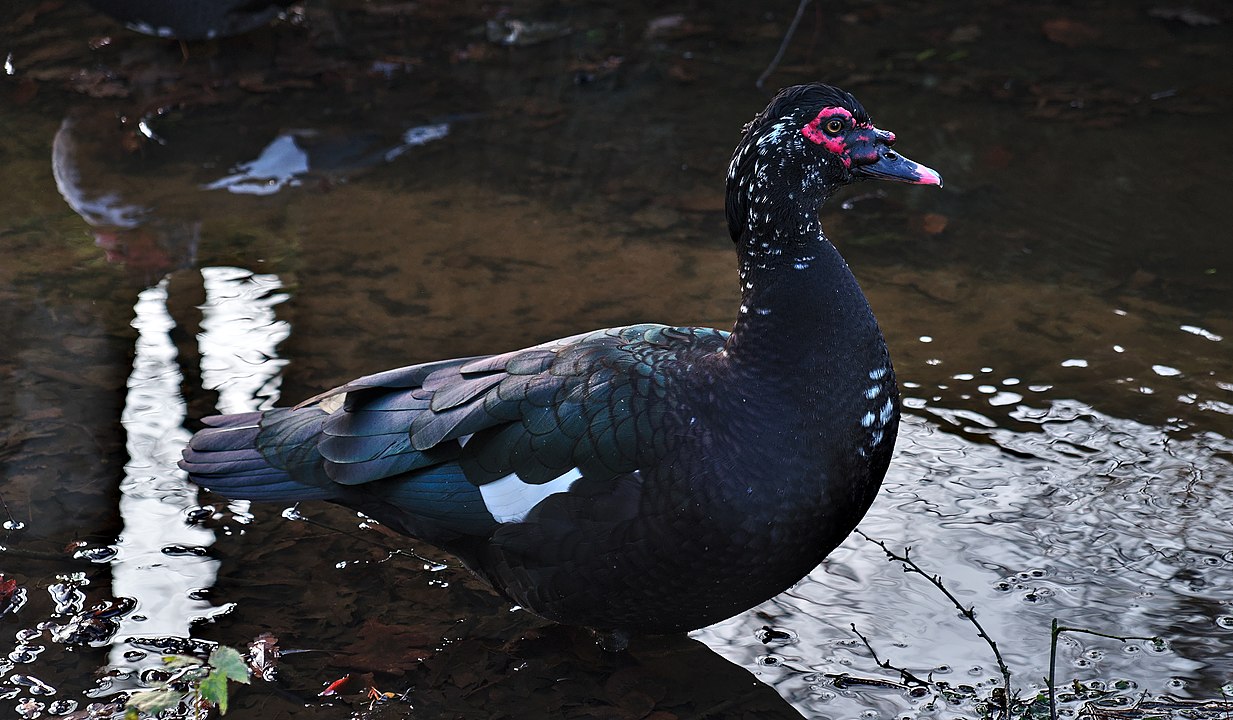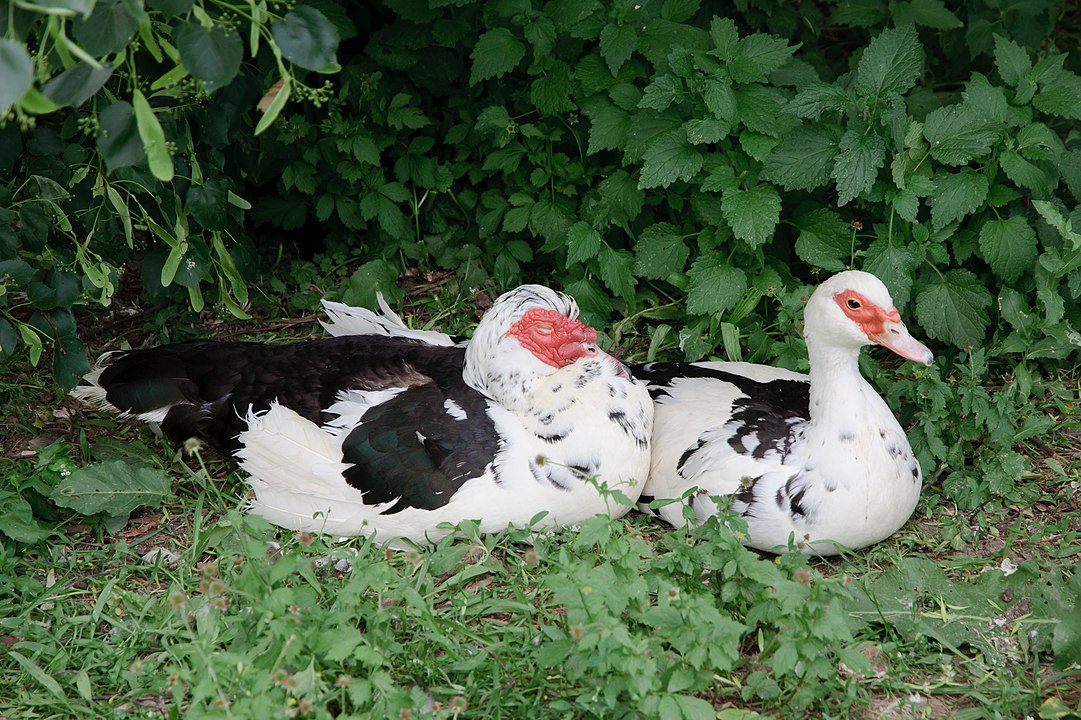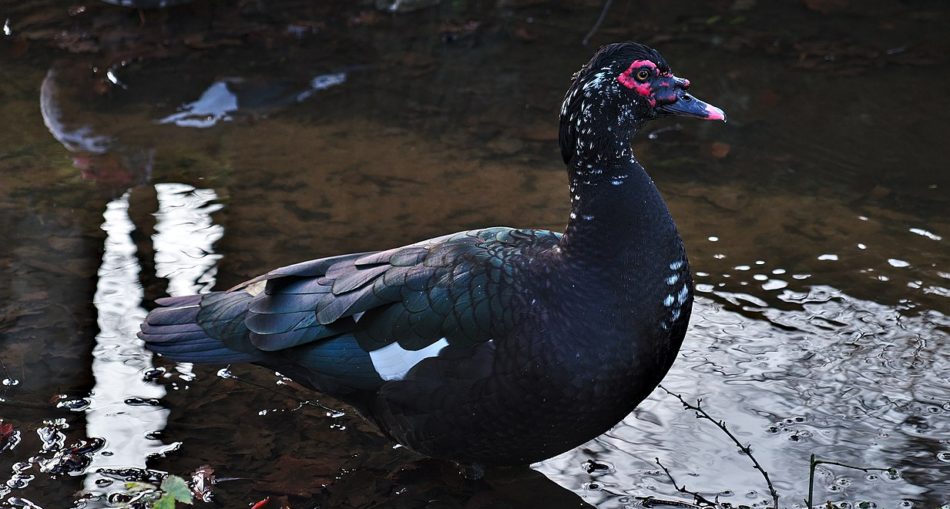Muscovy ducks are a local breed of ducks, mainly bred for their meat. They all originated from the wild Muscovy Duck. The scientific name of the wild Muscovy is Cairina moschata, however, the domesticated breed is known as Cairina moschata domestica. The domestic breed is also known as the creole duck or ‘pato criollo’ in Spanish. The genus Carina, meaning ‘the musky one from Cairo’ was named because of a misunderstanding. It was believed that the birds came from Egypt but it was however traced back to Aldrovandi. Muscovies are native to Mexico, Central America and South America in countries like Guyana. Read on to find out about the differences of Muscovy Ducks in the wild and in domesticity.

Wild Muscovy Duck – Photo By Trougnouf – Own work, CC BY-SA 4.0, https://commons.wikimedia.org/w/index.php?curid=66066516
Description Of The Muscovy Duck
The wild Muscovy Duck ranges in length of sixty-six to eight-four (66-84) cm with a weight of two to nine (2-9) lbs. Their wingspans are about one hundred and thirty-seven to one hundred fifty-two (137-152) cm. Wild Muscovies are usually black in colour. They have a short crest on their napes with a black bill, dotted in pale pink. The wild ducks have a dark red or blackish knob at the base of their bills. The skin of their faces is similar to this colour. Legs and webbed feet are black and have the same long claws like the domesticated breed. Females, have similar plumage and are much smaller without a knob or any feathers on their face. The younger birds are duller in colour and have little or no white on their upper wings. All Muscovy Ducks have flat, wide tails.
In domesticity, the male Muscovy drake is about eighty-six (86) cm in length and weighs about ten to fifteen (10-15) lbs. Females are about sixty-four (64) cm long with a weight of about six to eight (6-8) lbs. The domesticated birds look similar to their wild counterparts. Most are either dark brown or black mixed with white, especially their heads. Some may have entirely pure white plumage. Male and females share either a black-and-red or an all-red face. However, drakes have well-defined caruncles at the base of the bill and a low crest of feathers, mixed in colour. Ducklings are usually yellow with spots of brown on their tails and wings. Some may have dark heads and blue eyes, a light brown crown or dark marks on the napes.

A Pair of Muscovy Ducks – Photo By MrPanyGoff – Own work, CC BY-SA 3.0, https://commons.wikimedia.org/w/index.php?curid=26383192
Scientific Classification Of The Muscovy Duck
- Kingdom: Animalia
- Phylum: Chordata
- Class: Aves
- Order: Anseriformes
- Family: Anatidae
- Genus: Cairina
- Species: C. moschata
Habitat Of The Muscovy Duck
Wild, non-migratory Muscovy Ducks live in swampy forests, and grasslands, lakes, streams and tend to roost in trees during the night. Domesticated ducks typically live in pens, with designated nesting areas.
Diet Of The Muscovy Duck
Muscovy Ducks are active foragers and eat vegetation growing in shallow water and plant material such as stems, seeds, leaves and grasses. They also eat fish, insects, millipedes, crustaceans, reptiles and amphibians. Domesticated Muscovy Ducks are fed bran and other grains.
Behaviour Of The Muscovy Duck
Muscovy Ducks are social birds but can be aggressive to outsiders and fight over mates or territory. There is usually one dominant male while the rest remain bachelors. Males at the top of their social hierarchy protect their established territories and can be seen dominating other males with aggressive displays if pressed. These ducks are also very vocal, making hisses and quacks. Muscovy Ducks also tend to be visual, wagging their tails, moving their heads to and fro one another to communicate. The males raise their crest in order to attract females and to establish dominance, especially during the mating season. Muscovy ducklings are able to run as soon as they hatch and as such, are precocial birds. They can be pecked at by the adults, especially if they are eating from the same source of food.
Reproduction Of The Muscovy Duck
The Muscovy Ducks breed from the start of August to May but may breed at most three (3) times per year in domesticity. After mating, the hen makes her nest of twigs, stems and mud. Muscovy hens lay about eight to sixteen (8–16) white eggs per clutch and incubate them for thirty-five (35) days. The hen may leave only for drinking, eating and to defecate. The chicks break out of their shells in twenty-four (24) hours. Since their little bodies cannot produce enough heat to keep them warm soon after hatching, they huddle and stay close to their mothers. In the wild, the drake will stay with the brood for a few weeks, to protect them. Muscovy Ducklings are taught to feed when they are very young and they eat grass, eat insects, grains and corn.
5 Facts About The Wild Muscovy Ducks
- Wild Muscovy Ducks are feral and all domesticated breeds originated from them.
- The wild Muscovy looks a bit different from the domesticated breed. The wild breed tends to be smaller, weighing about two to nine (2-9) lbs as opposed to the ten to fifteen (10-15) lbs of the domesticated breed.
- In addition, they are typically black while the domesticated breed has black, white and grey plumage.
- Drakes usually stay with the hen and her brood for a few weeks to protect them before moving on.
- The wild ducklings will stay for about ten to twelve (10–12) weeks with their mother.
About The Muscovy Duck
The domestic Muscovy Ducks (Cairina moschata domestica) all originated from the wild Muscovy and as a result they share some characteristics. However, wild Muscovies, generally smaller and darker are more feral. Muscovies, in the wild and domesticity, are omnivorous creatures fond of feeding by ponds. Muscovies are territorial ducks and may become aggressive if threatened. This local breed of ducks also make an excellent duck curry.
Article Reference
- https://en.wikipedia.org/wiki/Muscovy_duck
- https://animaldiversity.org/accounts/Cairina_moschata/
- https://bioone.org/journals/anthropozoologica/volume-54/issue-1/anthropozoologica2019v54a13/The-modern-ontological-natures-of-the-Cairina-moschata-Linnaeus-1758/10.5252/anthropozoologica2019v54a13.short#:~:text=In%20its%20domestic%20state%2C%20Cairina,by%2024%20to%2028%20weeks.&text=The%20diet%20of%20Cairina%20moschata,while%20diving)%20and%20small%20reptiles.
Discover more from Things Guyana
Subscribe to get the latest posts sent to your email.







